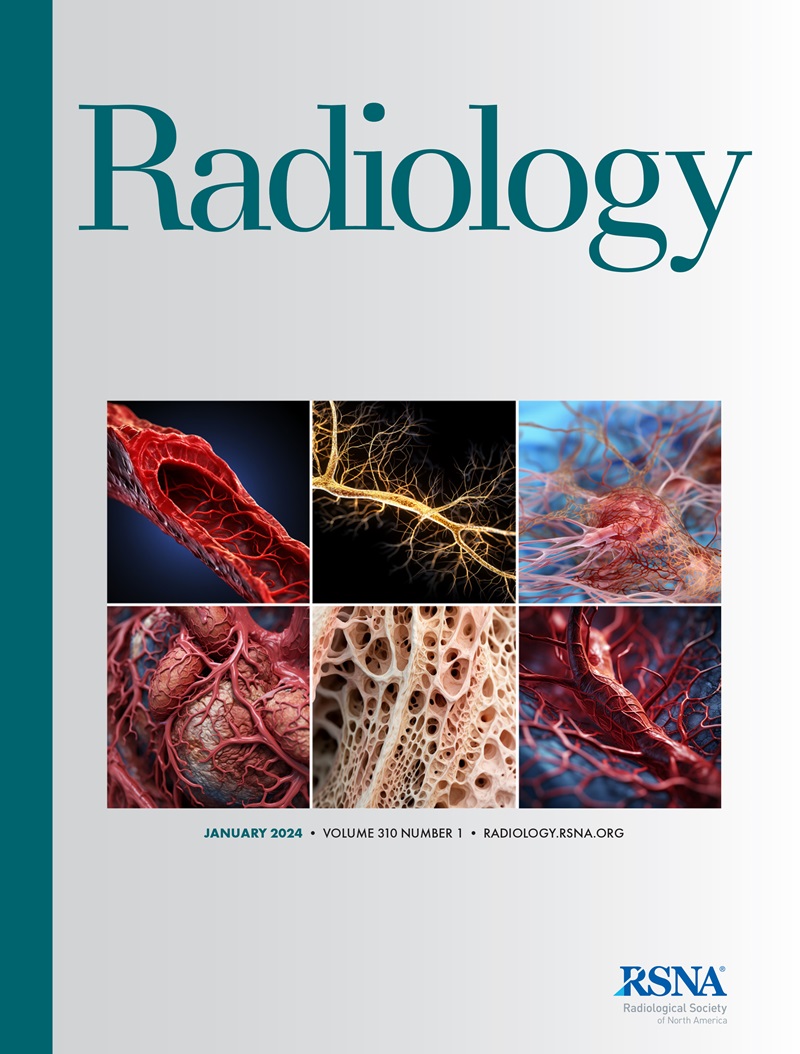Suzanne L van Winkel, Riccardo Samperna, Elizabeth A Loehrer, Jaap Kroes, Alejandro Rodriguez-Ruiz, Ritse M Mann
求助PDF
{"title":"Using AI to Select Women with Intermediate Breast Cancer Risk for Breast Screening with MRI.","authors":"Suzanne L van Winkel, Riccardo Samperna, Elizabeth A Loehrer, Jaap Kroes, Alejandro Rodriguez-Ruiz, Ritse M Mann","doi":"10.1148/radiol.233067","DOIUrl":null,"url":null,"abstract":"<p><p>Background Combined mammography and MRI screening is not universally accessible for women with intermediate breast cancer risk due to limited MRI resources. Selecting women for MRI by assessing their mammogram may enable more resource-effective screening. Purpose To explore the feasibility of using a commercial artificial intelligence (AI) system at mammography to stratify women with intermediate risk for supplemental MRI or no MRI. Materials and Methods This retrospective study included consecutive women with intermediate risk screened with mammography and MRI between January 2003 and January 2020 at a Dutch university medical center. An AI system was used to independently evaluate all mammograms, providing a case-based score that ranked the likelihood of a malignancy on a scale of 1-10. Different AI thresholds for supplemental MRI screening were tested, balancing cancer detection against the number of women needing to undergo MRI. Univariate analyses were used to explore associations between personal factors (age, breast density, and duration of screening participation) and AI results. Results In 760 women (mean age, 48.9 years ± 10.5 [SD]), 2819 combined screening examinations were performed, and 37 breast cancers were detected. Use of AI at mammography achieved an area under the receiver operating characteristic curve of 0.72 (95% CI: 0.63, 0.81) for the entire intermediate-risk population and 0.81 (95% CI: 0.69, 0.93) for women with prior breast cancer. Using a threshold score of 5, 31 of 37 (84%) breast cancers were detected, including 13 of 19 (68%) mammographically occult cancers, at a supplemental breast MRI rate of 50% (1409 of 2819 examinations). No significant association between breast density or age and the probability of a false-negative AI result was found. Conclusion Using AI at mammography to select women for supplemental MRI effectively identified women with higher breast cancer risk in an intermediate-risk population, including women with mammographically occult cancers. AI selection of women with intermediate risk for supplemental MRI screening has the potential to reduce screening burden and costs, while maintaining a high cancer detection rate. © RSNA, 2025.</p>","PeriodicalId":20896,"journal":{"name":"Radiology","volume":"314 2","pages":"e233067"},"PeriodicalIF":12.1000,"publicationDate":"2025-02-01","publicationTypes":"Journal Article","fieldsOfStudy":null,"isOpenAccess":false,"openAccessPdf":"","citationCount":"0","resultStr":null,"platform":"Semanticscholar","paperid":null,"PeriodicalName":"Radiology","FirstCategoryId":"3","ListUrlMain":"https://doi.org/10.1148/radiol.233067","RegionNum":1,"RegionCategory":"医学","ArticlePicture":[],"TitleCN":null,"AbstractTextCN":null,"PMCID":null,"EPubDate":"","PubModel":"","JCR":"Q1","JCRName":"RADIOLOGY, NUCLEAR MEDICINE & MEDICAL IMAGING","Score":null,"Total":0}
引用次数: 0
引用
批量引用
Abstract
Background Combined mammography and MRI screening is not universally accessible for women with intermediate breast cancer risk due to limited MRI resources. Selecting women for MRI by assessing their mammogram may enable more resource-effective screening. Purpose To explore the feasibility of using a commercial artificial intelligence (AI) system at mammography to stratify women with intermediate risk for supplemental MRI or no MRI. Materials and Methods This retrospective study included consecutive women with intermediate risk screened with mammography and MRI between January 2003 and January 2020 at a Dutch university medical center. An AI system was used to independently evaluate all mammograms, providing a case-based score that ranked the likelihood of a malignancy on a scale of 1-10. Different AI thresholds for supplemental MRI screening were tested, balancing cancer detection against the number of women needing to undergo MRI. Univariate analyses were used to explore associations between personal factors (age, breast density, and duration of screening participation) and AI results. Results In 760 women (mean age, 48.9 years ± 10.5 [SD]), 2819 combined screening examinations were performed, and 37 breast cancers were detected. Use of AI at mammography achieved an area under the receiver operating characteristic curve of 0.72 (95% CI: 0.63, 0.81) for the entire intermediate-risk population and 0.81 (95% CI: 0.69, 0.93) for women with prior breast cancer. Using a threshold score of 5, 31 of 37 (84%) breast cancers were detected, including 13 of 19 (68%) mammographically occult cancers, at a supplemental breast MRI rate of 50% (1409 of 2819 examinations). No significant association between breast density or age and the probability of a false-negative AI result was found. Conclusion Using AI at mammography to select women for supplemental MRI effectively identified women with higher breast cancer risk in an intermediate-risk population, including women with mammographically occult cancers. AI selection of women with intermediate risk for supplemental MRI screening has the potential to reduce screening burden and costs, while maintaining a high cancer detection rate. © RSNA, 2025.

 求助内容:
求助内容: 应助结果提醒方式:
应助结果提醒方式:


